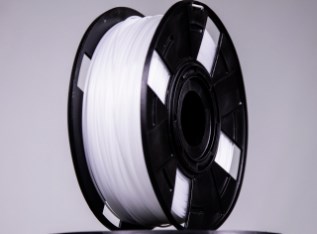Finally a Polypropylene You Can 3D Print
Sponsored ContentA new portfolio of polypropylene products from Braskem has finally solved the problem of excessive warpage in 3D printing applications. Finally, you can get the benefits of PP without the processing headaches.
Share
Polypropylene (PP) is well-known for its many desirable physical properties ranging from moisture and heat resistance to strength and dimensional stability. On top of all that, it is recyclable. With its many desirable physical properties, it is widely used for injection molding, extrusion and other molding processes, but it has been very difficult to use in 3D printing processes due to its tendency to warp upon cooling. This drives users to other materials such as PLA that may not have the exact physical properties the user needs, but are much easier to print.
However, thanks to recent advancements, users can now have access to more printable PP.
Weighing Options: Polypropylene or PLA

Polypropylene has numerous material benefits over PLA, including higher impact strength and improved resistance to chemicals and heat. Recent developments by Braskem have led to printable PP, reducing the tendency to warp during printing.
PP has long been used in plastics processes thanks to a variety of desirable physical properties. A good point of comparison is to PLA, which is widely used as an alternative in 3D printing because of its historically better processablity. PP is less dense than PLA, so it weighs ~30% less per volume. In addition to the benefits of this reduced weight for the end product, it means there is ~40% more material per pound of material.
Despite the reduced weight, PP has higher impact strength than PLA, is naturally chemical resistant, and the dimensional stability is quite high. It also resists deformation when exposed to high temperatures and can incorporate “living hinges” in builds. Moreover, it is recyclable. It does not absorb moisture, making it useful for certain applications and eliminating the need for storage in low-moisture environments.
According to Jason Vagnozzi, Commercial Director Additive Manufacturing & Digital Ventures at Braskem, the only reason that PP does not see more widespread use in additive manufacturing is its tendency to warp during cooling. “Its physical properties are downright better than PLA for many applications,” he says. “However, this tendency to warp has earned it the unfortunate nickname poly-warp-ylene.” Fortunately, Braskem’s new line of PP materials solved the printability problem.

Braskem and Advanced Laser Materials (ALM) partnered to develop PP400, a powdered form of polypropylene that is notable for its high-definition finishes. It frequently sees use in automotive and aerospace applications.
Printing with Polypropylene
Braskem is a well-established manufacturer of polyolefins, and the company saw a need for PPs in AM applications where customers were asking for more processible materials with better mechanical properties. Eventually, the company developed printable PP that is just as easy to use as PLA. “If you can print with PLA, you can print with our PP,” Vagnozzi says.
Braskem’s new PP offerings come in three varieties:
- Filament – Designed for use in Fused Filament Fabrication (FFF), this is appropriate for printing jigs and fixtures, making molds, prototyping, and iterating designs. Filament offerings include FL900PP-CF, a filament that uses recycled carbon fiber to further increase the material’s strength and rigidity with minimal shrinkage and warpage. Another filament is FL100PP, which is ideal for rapid prototyping and has high chemical resistance. Finally, the high fatigue strength of FL105PP makes it ideal for parts with complex features and geometries.
- Pellets – Intended for high-speed extrusion, the pellets are useful for high-volume runs. The GR100PP variety is ideal for general-use applications, owing to the low density, high strength, and resistance to chemical changes or water absorption. On the other hand, GR105PP is designed for more complex designs and geometries.
- Powder – For selective-laser sintering (SLS), the powder can provide high-definition finishes. Additionally, powder that has incidentally melted to the bed can be reused, reducing costs. The only current variety available is PP400, which has a balance of strength and impact resistance that makes it ideal for automotive and aerospace applications.

Useful for high-volume runs, GR100PP pellets are excellent in most general-use applications.
The company is not done there, either. “Customers can expect to see EVAs, Green polymers and polyethylene in the future,” Vagnozzi says. Additionally, the company is developing post-consumer recyclable polymers using PP. “The use of recycled content is much more economical with AM than injection molding, opening the doors for many exciting possibilities” according to Vagnozzi.
Increasing Performance with Fiber reinforced PP
You can also increase the performance of PP for AM by incorporating different fibers into the formulation such as glass fibers, cellulosic fibers and carbon fiber. Braskem’s latest innovation is an easy to print Carbon Fiber-reinforced PP filament, FL900-PP. Made from 100% recycled carbon fiber, this PP filament is up to six times stronger than a Braskem’s virgin PP filament formulation. In one internal study, Braskem was able to utilize this new formulation to print a drone arm that was 37% lighter than the factory-built arm. This enabled the team to realize a 4% increase in flight time and a 63% stress reduction, which made the drone arm much more resistant to breakage during crash landings and high impacts scenarios.
Accessibility
To further improve the accessibility of the product, Braskem has made it easy to purchase online, rather than through third-party distributors. Additionally, the company has a 3D-printing lab that enables customers to experiment with the material before committing to any purchases. “This lets our customers develop parts and realize the material benefits of PP using their own parts as examples,” Vagnozzi says.
For more information on Polypropylene, go to https://www.braskem.com/usa/3d-printing. For purchasing information, check out https://mholland3d.com/.
